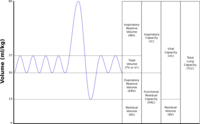
Photo from wikipedia
INTRODUCTION Interpreting pulmonary function test (PFT) results requires a valid reference set and a cut-off differentiating pathological from physiological pulmonary function; the lower limit of normal (LLN). However, in diving… Click to show full abstract
INTRODUCTION Interpreting pulmonary function test (PFT) results requires a valid reference set and a cut-off differentiating pathological from physiological pulmonary function; the lower limit of normal (LLN). However, in diving medicine it is unclear whether an LLN of 2.5% (LLN-2.5) or 5% (LLN-5) in healthy subjects constitutes an appropriate cut-off. METHODS All PFTs performed at the Royal Netherlands Navy Diving Medical Centre between 1 January 2015 and 1 January 2021 resulting in a forced vital capacity (FVC), forced expiratory volume in one second (FEV1) and/or FEV1/FVC with a Z-score between -1.64 (LLN-5) and -1.96 (LLN-2.5) were included. Records were screened for additional tests, referral to a pulmonary specialist, results of radiological imaging, and fitness to dive. RESULTS Analysis of 2,108 assessments in 814 subjects showed that 83 subjects, 74 men and nine women, mean age 32.4 (SD 8.2) years and height 182 (7.0) cm, had an FVC, FEV1 and/or FEV1/FVC with Z-scores between -1.64 and -1.96. Of these 83 subjects, 35 (42%) underwent additional tests, 77 (93%) were referred to a pulmonary specialist and 31 (37%) underwent high-resolution CT-imaging. Ten subjects (12%) were declared 'unfit to dive' for various reasons. Information from their medical history could have identified these individuals. CONCLUSIONS Use of LLN-2.5 rather than LLN-5 for FEV1/FVC in asymptomatic individuals reduces additional investigations and referrals to a pulmonary specialist without missing important diagnoses, provided a thorough medical history is taken. Adoption of LLN-2.5 could save resources spent on diving medical assessments and protect subjects from harmful side effects associated with additional investigations, while maintaining an equal level of safety.
Journal Title: Diving and hyperbaric medicine
Year Published: 2021
Link to full text (if available)
Share on Social Media: Sign Up to like & get
recommendations!